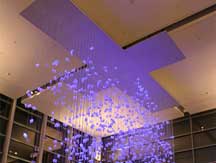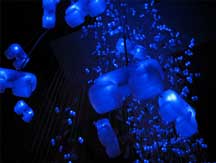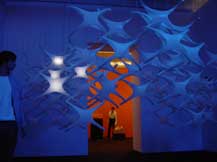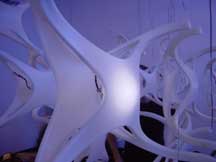Bion is a robotic sculpture that explores the relationship between humans and artificial life. The name makes reference to an individual element of primordial biological energy identified as orgone by Wilhelm Reich. The installation is a sensor network that is composed of 1000 glowing and chirping forms. Each bion is a synthetic “life-form” consisting of a tiny computer, an audio speaker, blue LEDs, and sensors.


As a visitor approaches the installation space, one of the bions is alerted and quickly communicates the presence of a stranger to the swarm of bions. One by one, in rapid succession, the bions signal other bions of the intruder and, in a wave-like pattern, become silent. The bions eventually become accustomed to the visitor’s presence and begin to respond to her/him as if s/he was part of their ecosystem. They become attracted to her and glow more intensely when she nears. Eventually, s/he is incorporated into the dynamic array.
By Adam Brown and Andrew H. Fagg, University of Oklahoma.
Another responsive field: Lattice archipelogics.
Distributed “sensitive” modules are reacting on the proximity of people approaching and entering the hybrid field of the lattice, translating the motion of individuals into ambient spatial patterns into light and sound.

 Inhabitants turn into visitors, users or even actors in these new spatial scenarios, which is spelling another shift in defining architecture as a form of shaping environments.
Inhabitants turn into visitors, users or even actors in these new spatial scenarios, which is spelling another shift in defining architecture as a form of shaping environments.
Designed by Servo and Smart Studio/Interactive Institute. Images from Toby Schneidler‘s website.
